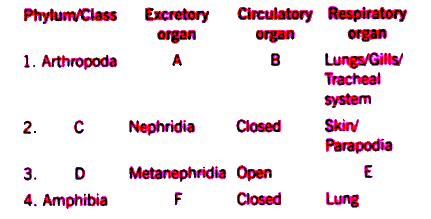Complete the following paragraph by filling in the blanks (i) to (v) with appropriate words:
(i) __________ make up about 80% of the animal kingdom. Their bodies have a hard, outer covering or exoskeleton made up of a proteinaceous substance called (ii) ________ The body is divided into a (iii) __________ thorax, and (iv) _______ It also bears multiple pairs of jointed legs. Arthropods also have antennae and (v) ________ on their heads.
To complete the paragraph, we will fill in the blanks with the appropriate words based on our knowledge of arthropods.
1. The first blank states that __________ make up about 80% of the animal kingdom. The correct word here is arthropods. Arthropods are indeed the largest phylum in the animal kingdom, accounting for a significant majority of all animal species.
2. The second blank mentions that their bodies have a hard, outer covering or exoskeleton made up of a proteinaceous substance called (ii) ________. The appropriate word for this blank is chitin. Chitin is a tough, flexible substance that forms the exoskeleton of arthropods.
3. The third blank asks for a division of the body, which is divided into a (iii) __________ thorax. The correct term to fill this blank is head. The body of arthropods is typically divided into three main parts: the head, thorax, and abdomen.
4. The fourth blank requires another division of the body, which is (iv) _______. The suitable word for this blank is abdomen. The abdomen is the last segment of the body in arthropods.
5. The fifth blank states that it also bears multiple pairs of jointed legs. Arthropods also have antennae and (v) ________ on their heads. The correct word to fill this blank is sensory organs. These sensory organs help arthropods to perceive their environment.
Putting it all together, the completed paragraph reads:
(i) Arthropods make up about 80% of the animal kingdom. Their bodies have a hard, outer covering or exoskeleton made up of a proteinaceous substance called (ii) chitin. The body is divided into a (iii) head, thorax, and (iv) abdomen. It also bears multiple pairs of jointed legs. Arthropods also have antennae and (v) sensory organs on their heads.
Topper's Solved these Questions
- MODEL TEST PAPER IIBOOK - ICSECHAPTER - MODEL TEST PAPER IIEXERCISE - SECTION II
57 Videos
- MODEL TEST PAPER IIBOOK - ICSECHAPTER - MODEL TEST PAPER IIEXERCISE - SECTION I (CHOOSE THE CORRECT ANSWER)
5 Videos
- MODEL TEST PAPER IBOOK - ICSECHAPTER - MODEL TEST PAPER IEXERCISE - SECTION II (GIVE THE BIOLOGICAL TERM FOR THE FOLLOWING)
9 Videos
- PHOTOSYNTHESIS AND RESPIRATION IN PLANTS BOOK - ICSECHAPTER - PHOTOSYNTHESIS AND RESPIRATION IN PLANTS EXERCISE - Exercises (Explain in brief.)
9 Videos
Similar Questions
Knowledge Check
The exoskeleton of cockroach is made up of
AchitinBcellulaseCglycogenDcuticle
In maize seed, the outer covering of andosperm separates the embryo by a proteinaceous layer called
View SolutionAbout 50 per cent of our body is made up of water.
View SolutionAn arthropod having unjointed legs is
View SolutionFill up the blanks appropriately :

View SolutionComplete the following paragraph by filling in the blanks (i) to (x) with appropriate words :
(i)__ is the process of transfer of (ii)___ from the anther to the stigma. The anthers of the (iii)___ produce powdery particles called (iv)____. Each pollen grain contains (v)____ that participates in reproduction. To initiate the process of formation of (vi)____ and (vi)____ the pollen grain must first reach the (viii)____ . When pollen of the same flower falls on its own stigma, it is called (ix)____, whereas when pollen of another flower of the same plant falls on the stigma, it is called (x)____.
View SolutionComplete the following paragraph by filling in the blanks (1) to (V) with appropriate words:
The amount of urine output is under the regulation of a hormone called (i)___________ secreted by the (ii)__________lobe of the pituitary gland. If this hormone secretion is reduced, there is an increased production of urine. This disorder is called (iii)__________ . Sometimes excess glucose is passed with urine due to hyposecretion of another hormone called (iv) __________ leading to the cause of a disease called (v)__________
View SolutionThe exoskeleton of arthropods is made up of _____
View Solution




